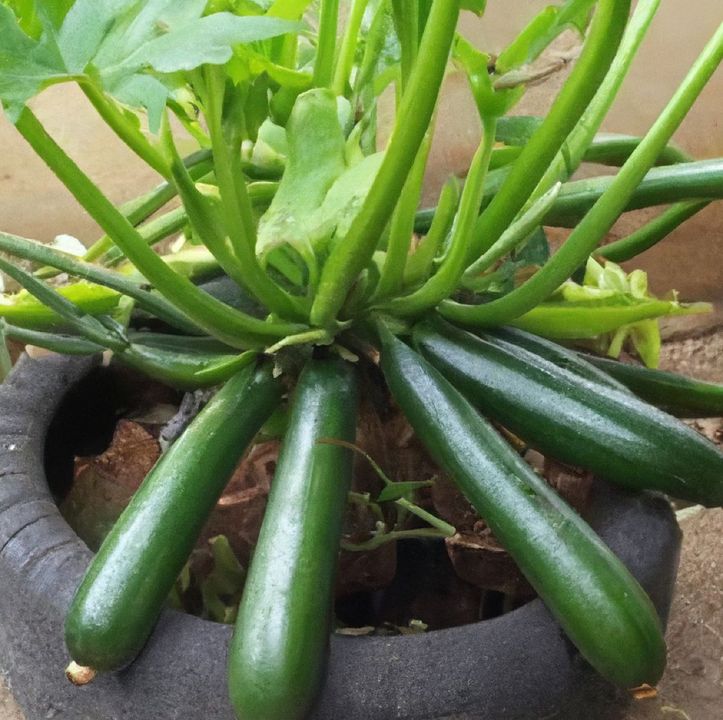Step 5: Water and Mulch
ADVERTISEMENT

ADVERTISEMENT
Check out the brilliant gardening technique used to grow zucchini
After planting the zucchini seeds or seedlings, water the tire planter thoroughly until the soil is evenly moist. Be careful not to overwater, as zucchini plants prefer slightly dry conditions rather than being waterlogged.
Apply a layer of organic mulch, such as straw or wood chips, around the base of the zucchini plant. Mulching helps retain soil moisture, suppresses weed growth, and regulates soil temperature.
Step 6: Provide Care and Maintenance
To ensure healthy growth, it’s important to provide proper care and maintenance for your zucchini plant. Here are some key points to consider:
Watering: Zucchini plants need consistent watering, especially during hot and dry periods. Water the plant deeply once or twice a week, allowing the soil to dry out slightly between watering sessions.
Fertilization: Feed your zucchini plant with compost or organic fertilizer every few weeks to provide a continuous supply of nutrients. Follow the package instructions for application rates.
Pruning: Regularly remove any yellow or diseased leaves to promote air circulation and prevent the spread of diseases. Pruning also helps redirect energy to fruit production.
Pollination: Zucchini plants require pollination to produce fruit. If you don’t notice bees or other pollinators in your garden, you can hand-pollinate the flowers using a small brush or by gently shaking the plant.
Pest and Disease Management: Monitor your zucchini plant for common pests like aphids, squash bugs, or powdery mildew. Use organic pest control methods or consult with your local gardening expert for appropriate solutions.
Step 7: Harvesting
Zucchini plants typically start producing fruit within 40 to 60 days from planting. Harvest the zucchini when they reach 6 to 8 inches in length, as smaller fruits are more tender and flavorful. Use a sharp knife or pruning shears to cut the zucchini from the plant, avoiding any damage to the stem or leaves.
Can you use another planter outside of tires? If so, what?
Absolutely! While using tire planters is a creative and resourceful option, there are several other planter options you can use to grow zucchini outdoors. Here are a few alternatives:
– Raised Beds: Raised beds are a popular choice for growing vegetables, including zucchini. Construct or purchase a raised bed made of wood, stone, or composite materials. Make sure it’s deep enough to accommodate the zucchini’s root system and provides adequate drainage.
– Containers: Large containers such as plastic or ceramic pots can be an excellent alternative to tire planters. Choose a container that is at least 18-24 inches deep and wide to provide enough space for the zucchini plant. Ensure the container has drainage holes to prevent waterlogging.
– Grow Bags: Fabric grow bags are lightweight, portable, and offer good drainage. They are available in various sizes and can accommodate zucchini plants. Choose a larger size, such as a 10-gallon or 15-gallon bag, to provide ample room for root growth.
– Wooden Barrels: Old wooden barrels or half barrels can make charming planters for zucchini. Make sure to drill drainage holes in the bottom and line the barrel with a plastic sheet or use a water-permeable fabric to prevent soil erosion.
– Pallet Planters: Upcycled pallets can be transformed into vertical planters. Attach landscape fabric or burlap to the back of the pallet, fill the spaces between the slats with potting soil, and plant zucchini seedlings in the openings. This allows you to grow zucchini vertically, saving space.
– Garden Beds: If you have ample garden space, planting zucchini directly in the ground is an option. Prepare the soil by amending it with compost or organic matter to improve fertility and drainage. Ensure the garden bed receives sufficient sunlight and has proper spacing between plants.
ADVERTISEMENT
ADVERTISEMENT
